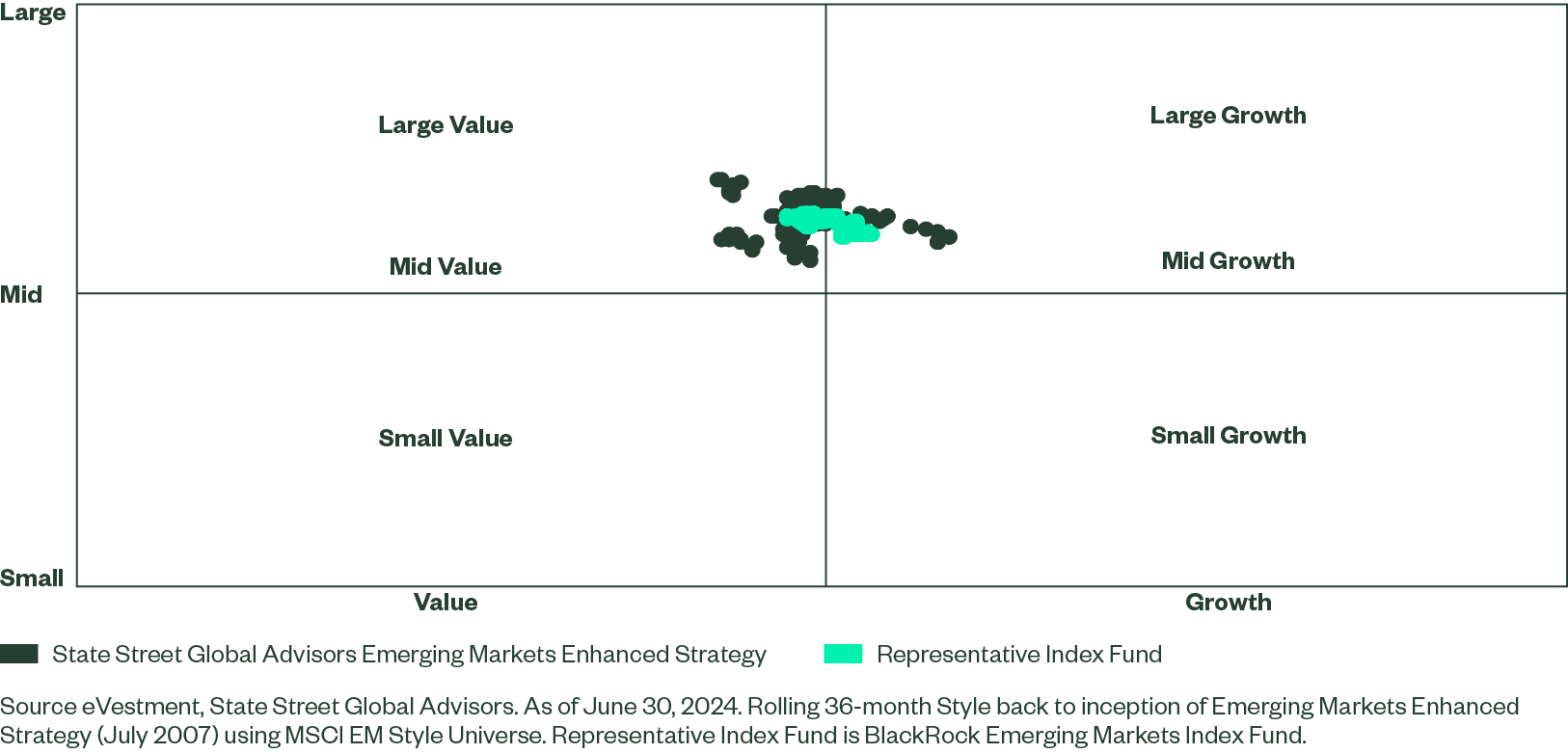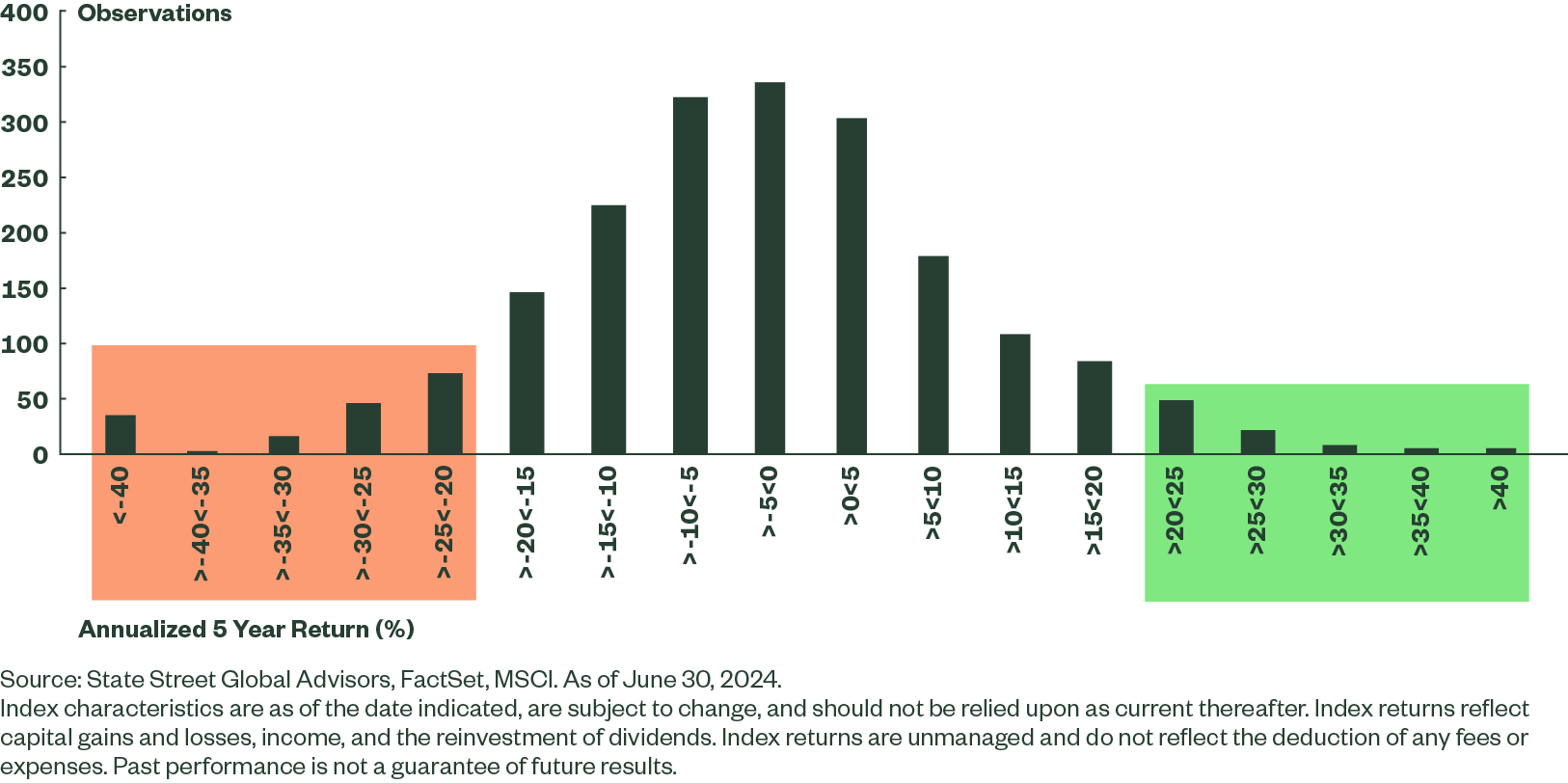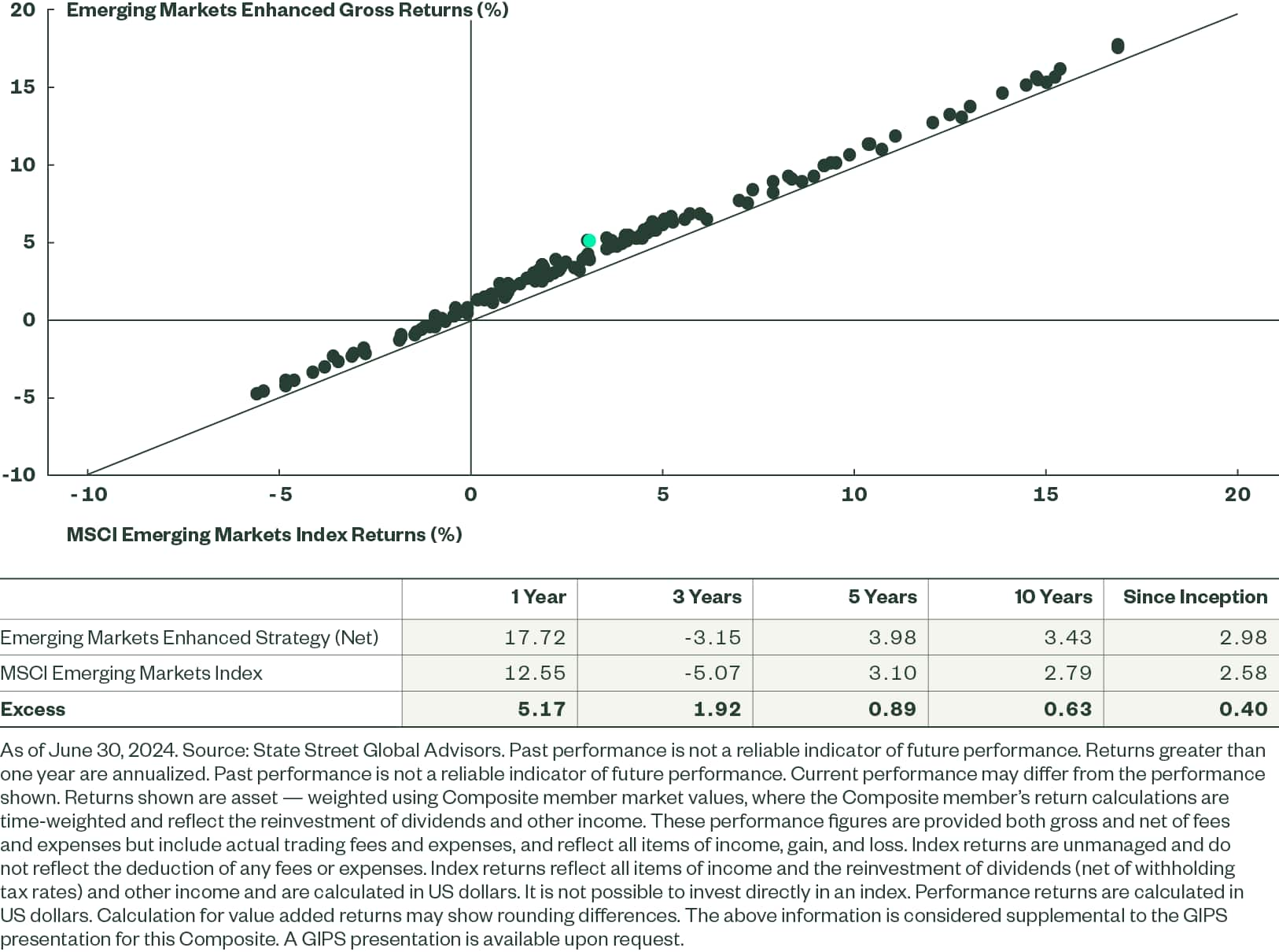An Enhanced Approach to Broad Emerging Markets Equity Exposure
Once considered a speculative, high-risk asset class, emerging markets have become a core allocation in a diversified portfolio. But are investors now treating emerging markets equities too much like their developed market counterparts – specifically with index tracking solutions? In this article, we discuss some unique characteristics of the EM index, the drawbacks of passive investing in EM, and why the asset class is better suited for a more sophisticated approach.
Emerging markets have evolved dramatically in the five decades since our Systematic Equity Active Team began investing in the asset class. In their nascent beginnings in the 1980’s, emerging markets equities (EM) represented less than 1% of the MSCI All Country World Universe. Today, they make up more than 10% of global equities and are integrated across global supply chains – from raw materials and capital goods, to more advanced technologies such as semiconductors, solar energy, electric vehicles, and Artificial Intelligence. This development and growth shifted the perception of the asset class over time from a speculative, high-risk allocation to an essential component of a diversified global portfolio. Although EM has graduated to a core allocation, we fear that investors have become too quick in applying a developed market mentality, specifically the utilization of a passive indexing approach. While we understand the attraction of a low-cost, low-risk investment, we believe there is a superior alternative for emerging markets core exposure.
Challenges to Index Investing in Emerging Markets
The objective of an index strategy is to produce a portfolio that mimics, as closely as possible, a frictionless benchmark by minimizing tracking or slippage from the index. Two of the primary challenges portfolio managers face when seeking to achieve this objective are index turnover (due to index reconstitution) and the costs associated with trading. In developed markets (DM), the decision to use an index solution has strong merits; the index has relatively low turnover, stocks are liquid, transaction costs are low, and markets are fairly efficient. Conditions are more challenging, however, in emerging markets; index turnover is nearly three times that of DM1 , trading costs are typically more than double2 and markets are significantly less efficient.
Thus, while EM investors are enticed by the ever-decreasing costs of EM index funds, they often experience higher tracker error than developed market index funds with the possibility of underperforming the index. For this reason, we strongly believe that emerging markets equities are a fertile asset class for a slightly more active approach that can substitute unintended tracking error with more refined index deviations that deliberately seek to generate positive alpha.
An Alternative Solution
Our Systematic Equity Active Team’s Emerging Markets Enhanced Strategy offers a portfolio with the look and feel of the index but with the benefits of a sophisticated, bottom-up alpha model or stock selection model. The model utilizes a state-of-the-art infrastructure, collecting and analyzing the latest fundamental, technical, and macroeconomic data available on over 5,000 emerging markets stocks (as of June 30, 2024). When combined with our systematic optimization process, we are able to construct a well-balanced portfolio with a tilt to names with strong fundamentals, improving market sentiment, and attractive valuations (Figure 1).3
Figure 1 – Strategy Characteristics Versus Benchmark

To ensure the portfolio provides core index-like exposure, we allow only small active deviations from the index, diversifying risk across hundreds of securities. The end result is an alpha-seeking strategy that delivers only a slight increase in style drift when compared to a leading Index fund (Figure 2).
Figure 2 – Style Map Comparison Against Index Fund

Consistency is Key
Minimizing dramatic swings from the cap-weighted benchmark is critical for core investors. We look to add incremental alpha that allows the law of compounding returns to work its magic over time. Consistency is the key to this approach, and given the volatile nature of EM, risk control is essential to achieve this desired result, and therefore is a critical component of our process. While all segments of the market are exposed to unknown unknowns - or black swans – EM equities are among the most susceptible. Figure 3 below illustrates the distribution of EM equity returns over the past 5 years. Notice anything?
Figure 3 – Emerging Markets Equities Exhibit Skewed Returns

Not only does the distribution have ‘fat’ tails, but also negative skew. This is consistent with market inefficiencies that exist within EM, and although they do lead to opportunities for outperformance, the fact there are a greater number of observations on the left hand side implies that concentrated managers run a high risk of holding a negative outlier that can take a long time to recover from. With this in mind, to deliver consistency we must minimize stock-specific risk, and seek to win by not losing.
By applying tight constraints at the security, country and sector level, along with imbedding a risk model within the optimization process, the strategy delivers a highly risk-controlled portfolio of around 700 names, allowing the bottom-up alpha model to drive active stock positions. This helps not only to limit macroeconomic, geopolitical, currency and stock-specific risk, but also to deliver highly consistent returns relative to the benchmark.
Figure 4 – Rolling 5-Year Batting Average Since Inception

Taking Advantage of the Optimal Segment of the Active Risk Spectrum
Not only does this approach offer consistency, it also allows investors to take advantage of the most fruitful segment of the active risk spectrum where additional alpha can be achieved with the least amount of additional risk, or where Information Ratios (IRs) are typically maximized. No question, investing in emerging markets can be a wild ride – in just the last year we have seen markets impacted by Middle East tensions, an escalation of cross-strait relations between China and Taiwan, and surprise election results in India. It is extremely challenging if not impossible to diversify away these types of systematic risks without avoiding the asset class all together. The most successful investors in these markets are those that are as efficient as possible in their usage of nonsystematic (i.e. diversifiable) risk. The Emerging Markets Enhanced Strategy was designed to maximize return per each unit of risk taken, and this is perhaps best demonstrated via an examination of our Information Ratio:
Information Ratio (Efficiency) = Excess Returns/Active Risk (Tracking Error)
Higher IR portfolios are indicative of managers that are most proficient at utilizing risk to generate excess returns. So how does our Emerging Markets Enhanced Strategy stack up on an Information Ratio perspective relative to peers?
Figure 5 – Information Ratio, Excess Return per Unit of Risk

Safe to say, very well. We have delivered top-decile Information Ratios across 1-, 3-, 5-, and 10-years by remaining disciplined and resisting the temptation to assume more risk.
Our research clearly indicates that the first incremental risk additions generate the highest returns per unit of risk. As funds take on more risk they encounter diminishing returns (those fat tails again!), and we are quite comfortable living in the sweet spot that the Emerging Markets Enhanced Strategy provides.
Evolution
While we take great pride in the success of our Emerging Markets Enhanced Strategy, we are acutely aware that emerging markets are constantly evolving, and to stay ahead, our alpha model must also evolve alongside them. Recent research projects that have been incorporated into the product include applying AI technology to interpret management earnings calls, an analysis on the unique structure of the China A universe and the opportunities it presents, along with a multitude of others. An in-depth review on the State Owned Enterprises has also been completed (as of July 2024) and is in the process of being integrated into the live model.
On the product side we have had great success in evolving the EM Enhanced strategy to meet various offerings. Our disciplined approach and great alpha signal lends itself to portability and scalability, and we are now able to offer investors sustainable versions of the strategy with similar performance track records. More recently, we have also successfully adapted the strategy to customized indices for clients, without sacrificing alpha.
The Bottom Line
Over the last three years there has been a growing consensus with investors that the economic growth reacceleration story within EM is appealing. Net flows into EM equities have been positive every year since 2021, but the vast majority of this capital has flowed to passive ETFs. We urge investors to pay attention to index turnover, transaction costs, and fees that are inherent within emerging markets – the efficiency with which developed markets indices are replicated does not necessarily translate to emerging markets. These inefficiencies all too often result in performance drag with costly consequences.
We strongly believe that our disciplined, systematic active process may be a preferable option that has the ability deliver consistent excess returns relative to the index, while providing core index-like exposure at a competitive fee.